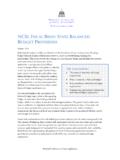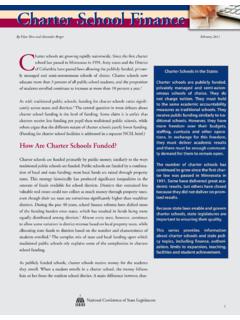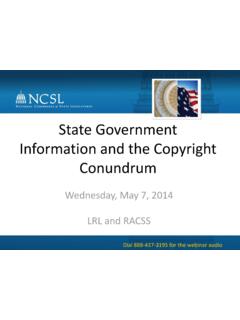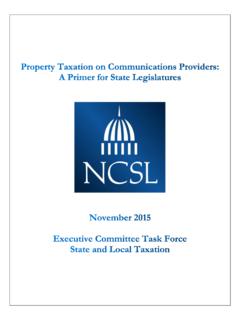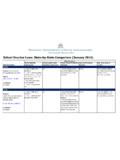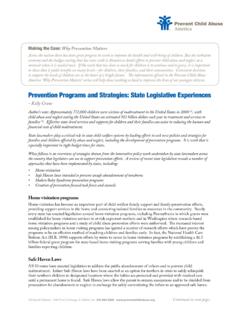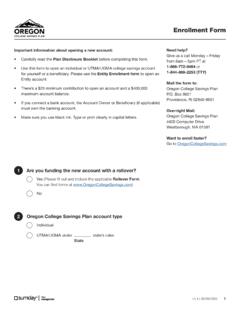Transcription of Bills and Bill Processing - Legislative News, Studies and ...
1 Bills and bill Processing 3-31 The Engrossing Process For a bill , introduction and enactment are the beginning and the "hoped for" end of the Legislative process. However, very few pieces of legislation are passed in the same form in which they were introduced. Sponsors may be added or deleted. Amendments may be adopted by standing committee, the house of origin, the second chamber or conference committee. How do Legislative chambers deal with the intermediate changes that occur between introduction and enactment? The vast majority of legislatures employ a process called "engrossing." However, the definition of "engross" varies among Legislative assemblies. For this report, engrossing is defined as the process by which a bill is updated--that is, how adopted amendments and other changes are incorporated into a bill --as it makes its way through the Senate or House.
2 The process used. When considering the Legislative engrossing process, there are three main questions. They are: 1. Are Bills engrossed? 2. If yes, when? 3. If yes, how? Are Bills engrossed? Only six Legislative assemblies--the Connecticut Senate, Delaware House, New Mexico Senate and House, New York Assembly, and Utah Senate--reported that they do not engross Bills . In contrast, 83 chambers incorporate changes to Bills as a regular part of their Legislative process. (See table ) When are Bills engrossed? Tables and show the points in the Legislative process at which Senate and House Bills are engrossed. Typically, a bill is updated only by the chamber in which it originated; that is, House Bills are engrossed by the House, and Senate Bills are engrossed by the Senate. In most Legislative bodies, the engrossing occurs: Before a bill receives its third reading or final passage vote in the house of origin; or Before a bill is transmitted to the opposite chamber.
3 Some chambers update Bills more often. For example, in the California Senate and Assembly, Idaho House, Minnesota Senate and House, Montana Senate and House, Nevada Senate and Assembly, New Jersey General Assembly, Pennsylvania Senate and House, South Carolina Senate, and Vermont Senate, a bill is engrossed whenever amended by the body. In the Hawaii House, Ohio Senate and House, and Oregon Senate and House, a bill is updated if it is reported out of committee with amendments. In some instances, engrossing occurs upon the request of specific individuals such as the presiding officer, another leader, a committee chair, a member or the clerk or secretary. This is true in the Maryland House, Nebraska Senate, North Carolina House, North Dakota Senate and House, Oklahoma House, Utah House, Virginia House, and Wisconsin Senate and Assembly. How are Bills actually engrossed?
4 Table highlights the types of engrossing processes used. A manual ("cut and paste") system is used in 12 Legislative assemblies. In 69 chambers, the engrossing staff incorporate changes to Bills by manually manipulating electronic files. Eleven Legislative bodies--the Alabama House, Florida House, Indiana Senate, Iowa Senate and House, Kentucky Senate, Minnesota Senate and House, Virginia Senate, and Wisconsin Senate and Assembly--use a computerized, auto-engrossing process. National Conference of State Legislatures 3-32 Inside the Legislative Process When a bill is engrossed, most chambers differentiate the newest version from the original or other renditions. Table illustrates the various ways by which Legislative bodies indicate the differences. Frequently, the physical appearance of the versions varies. Forty-two chambers stamp "engrossed" on the printed bill .
5 In 22 Legislative assemblies, the bill number on printed copies has an engrossment indicator added. For example, HB 24-2ndE indicates the second engrossment of House bill 24. The Florida Senate, Indiana House, Montana Senate and House, North Carolina House, and Utah House use color-coding systems Just as printed copies of engrossed Bills differ, so do the computerized versions. Eighteen chambers add engrossment indicators to electronic bill versions. It is common for the computer file for each engrossment to be given a new name or number. This is true in 38 Legislative bodies. Correcting errors. The process of engrossing a bill is very exacting. The staff often deal with very complex or conflicting amendments and limited time frames. As a result, errors sometimes occur. The engrossing staffs in 64 chambers are allowed to fix minor grammatical or spelling errors (see table ).
6 However, the correction of substantive engrossing errors usually requires Legislative action, such as the adoption of an amendment or passage of a resolution. The Illinois Senate and House recall the bill from third reading and final passage and return it to second reading for amendment. In the Oregon Senate and House, the bill is returned to committee for correction. The Puerto Rico Senate may reconsider the bill on the next session day. Unofficial engrossments. Typically, when a bill is engrossed, a new, official version is created. Sometimes, however, a committee or a member "just wants to see what it'll look like" if numerous or complex amendments are added to a bill . In these instances, an "unofficial engrossment" may be requested. Not all chambers allow the creation of unofficial engrossments (see table ).
7 In fact, 47 Legislative bodies reported that these documents are not used. Thirty-five Legislative chambers reported that they use unofficial engrossments, but variety exists in the extent to which these documents occur. In 20 chambers, unofficial engrossments are rare. The Colorado House, Kansas Senate, Michigan House, Minnesota Senate and House and Vermont Senate and House fall at the other end of the spectrum, and the "what it looks like" renditions are very common. The majority of chambers that allow unofficial engrossments do not have formal processes by which to request them. Only 13 Legislative assemblies reported set procedures. For example, in the Maryland Senate and House, South Dakota Senate and House, and Tennessee Senate, the president or speaker must approve a request for an unofficial engrossment. The requests are made to the clerk in the Louisiana House and Oregon House, to the engrossing clerk or Senate counsel in the Minnesota Senate, and to the parliamentarian in the Pennsylvania House.
8 In the Kansas Senate, the revisor's office provides unofficial engrossments at the request of a committee chair or legislator. An unofficial engrossment is created automatically if a bill is amended and held over for further discussion in the Alaska House and Colorado Senate. In Nebraska, a member's request for a "white copy" must be approved by unanimous consent on the floor. Staffing. Who is responsible for engrossing Bills ? Most frequently, the work is assigned to the clerk's office or to a central, nonpartisan staff agency (see table ). The engrossing staff are part of the clerk's office in 47 chambers and part of a central staff agency in 32 Legislative bodies. Table indicates the number of people employed by Legislative bodies to perform this function during session and during the interim. National Conference of State Legislatures Bills and bill Processing 3-33 National Conference of State Legislatures 3-34 Inside the Legislative Process Table Which Chambers Engross Bills ?
9 The following chambers engross Bills : Alabama Senate and House Montana Senate and House Alaska Senate and House Nebraska Senate Arizona Senate and House Nevada Senate and Assembly Arkansas Senate New Jersey Senate and General Assembly California Senate and Assembly North Carolina House Colorado Senate and House North Dakota Senate and House Florida Senate and House Ohio Senate and House Georgia Senate and House Oklahoma Senate and House Hawaii Senate and House Oregon Senate and House Idaho Senate and House Pennsylvania Senate and House Illinois Senate and House Rhode Island House Indiana Senate and House South Carolina Senate and House Iowa Senate and House South Dakota Senate and House Kansas Senate and House Tennessee Senate and House Kentucky Senate and House Texas Senate and House Louisiana Senate and House Utah House Maine House Vermont Senate and House Maryland Senate and House Virginia Senate and
10 House Massachusetts Senate and House Washington Senate Michigan Senate and House West Virginia Senate and House Minnesota Senate and House Wisconsin Senate and Assembly Mississippi Senate and House Wyoming Senate and House Missouri Senate Puerto Rico Senate The following chambers do not engross Bills : Connecticut Senate New York Assembly Delaware House Utah Senate New Mexico Senate and House National Conference of State Legislatures Bills and bill Processing 3-35 Table When the Senate Engrosses Senate Bills State (1) Description Alabama Before being transmitted to the House if committee or floor amendments are adopted by the Senate Alaska After final passage but prior to transmittal to the House Arizona Prior to the third reading or final passage vote Arkansas Prior to the third reading or final passage vote California Prior to each reading of the bill .
